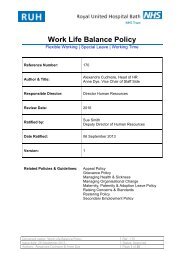You also want an ePaper? Increase the reach of your titles
YUMPU automatically turns print PDFs into web optimized ePapers that Google loves.
What is an <strong>Inguinal</strong> <strong>Hernia</strong>?<br />
A hernia is hole or weakness in the structure of the abdominal wall through which<br />
the contents of the abdomen can protrude. This results in a plum sized or larger<br />
swelling.<br />
Within the swelling is usually a sack which may contain some bowel (gut) or fatty<br />
tissue. In an inguinal hernia, the swelling protrudes downwards through the<br />
inguinal canal which is in the groin.<br />
The hernia may give rise to episodes of pain or discomfort in the groin region<br />
particularly when physically active or lifting heavy objects.<br />
What causes an inguinal hernia?<br />
The inguinal canal is a natural weak area where the round ligament of the uterus<br />
passes and attaches to the pubic bone.<br />
If the muscles around the canal stretch too much or tear than the contents of the<br />
abdomen (fat or bowel) may protrude through the canal creating an abnormal<br />
swelling.<br />
Any condition that increases pressure within the abdomen such as obesity,<br />
chronic cough as a result of smoking or chronic straining as a result of<br />
constipation may encourage the development of a hernia. Increased abdominal<br />
pressure during pregnancy may also be a contributing factor.<br />
The weakness may also occur as a result of straining to lift heavy objects or<br />
physical exercise.<br />
Page 2 of 6

















